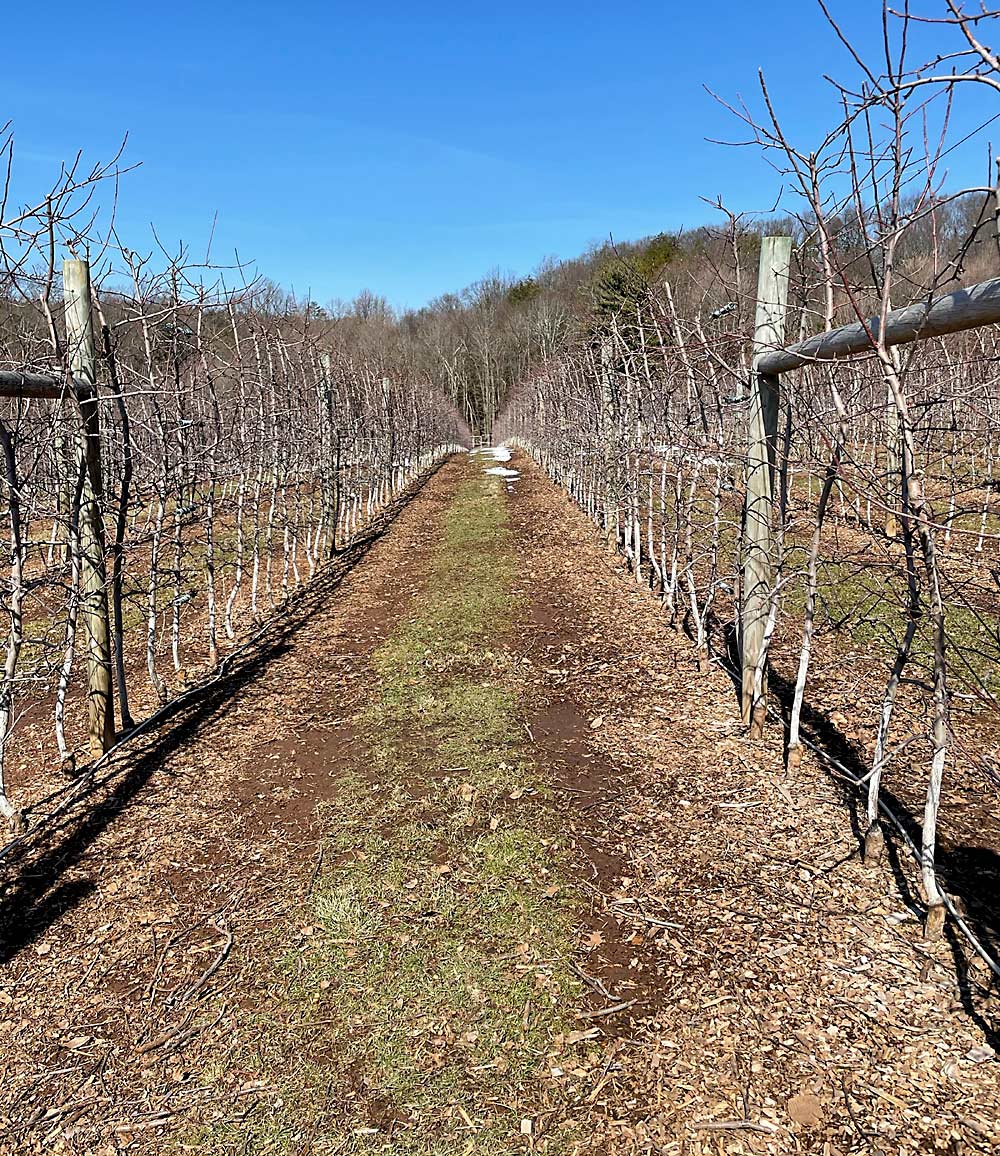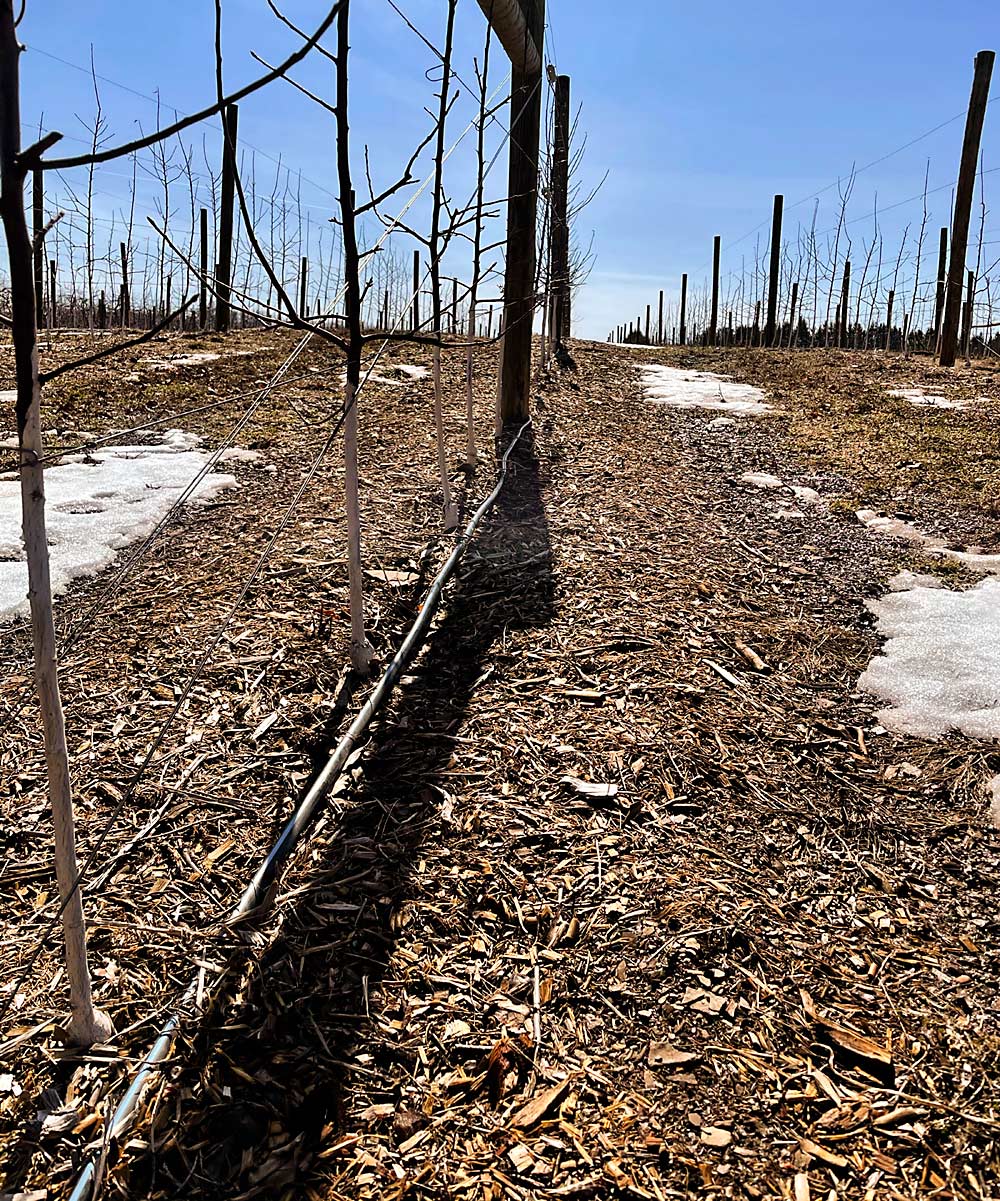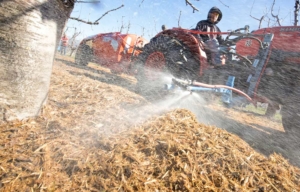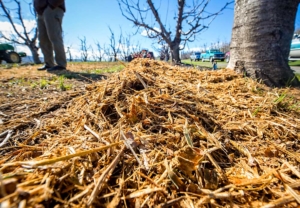
Like many another apple grower, Peter Rogers is taking out older plantings and replacing them at higher densities on Geneva rootstocks. And even though renovations stimulate weed growth, he found that the tighter tree and row spacings of dwarf plantings offer new opportunities for weed control.
Rogers, owner of Rogers Orchards in Southington, Connecticut, decided to use wood chips to suppress weeds. He’s always on the lookout for sustainable growing methods and for ways to refine his integrated pest management programs. He also likes to save money on herbicide applications. Plus, tree-service companies kept calling and asking if he would take wood chips off their hands, at no charge.
With 220 acres, Rogers Orchards is one of the largest apple growers in Connecticut. His apple sales are a mixture of wholesale, retail and U-pick. He first applied wood chips on a new high-density apple planting in 2016 and has slowly expanded from there. He’s laid chips on about 25 acres of apples now — nearly all of his recent plantings. His crews apply the wood chips with a mulch spreader just after planting, typically in May or June, before weeds emerge.
Before 2016, his orchard took a more conventional approach to weed control, using residual herbicides for prevention and burndown materials for spot treatments. Rogers wants to move away from the former and toward the latter — and so far, he’s using much less residual herbicide in those new plots.
On the negative side, wood chips can attract voles and other rodents, which like to burrow under them and chew on the root systems of young trees. Rogers hasn’t seen any rodent activity so far. Much of his orchard is on a ridge, and there are a lot of circling hawks that might be suppressing rodent populations, he said.
Rogers also wants to know if the mulch will improve the long-term health of his soil, and how much moisture it retains. Mary Concklin, a University of Connecticut extension educator and IPM program coordinator, will help him monitor his soil health and nutrient levels — comparing the differences between the blocks with wood chips and the blocks without them.

Concklin said wood chips are not a common mulch in Connecticut tree fruit but are used widely in blueberries. If they can prove that wood chips suppress weeds and lower herbicide use in orchards over the long term, that would make them a useful tool in a grower’s IPM toolbox.
It’s still early though, and Concklin has questions that need to be answered. How frequently should wood chips be applied, and how thickly should they be spread? Too thick might attract rodents. She also wants to see how well wood chips work in plantings where weeds already have taken over.
Maurice Tougas, owner of Tougas Family Farm in Northborough, Massachusetts, used wood chip mulch in his orchards in the 1990s, but he stopped when local power plants started competing for them and the chips became expensive. He continued to use them in blueberries.
Power plants have stopped buying wood chips, however, and the price has gone down, so Tougas started reapplying them in his orchards in the past few years.
He said wood chips don’t eliminate weeds entirely, but the pros of using them outweigh the cons. He’ll continue applying them as long as they’re affordable and he has the labor for it.
Use of wood chips has already made it easier for Tougas to favor burndown herbicides over preemergents. They keep soil cooler in summer and provide insulation in winter. They also help retain moisture in the soil — though staying too wet for too long can be a concern. He hopes the mulch will, in the long run, help improve the quality of his rocky New England soil.
Mice and voles haven’t yet become a problem. Tougas — who grows 30 acres of apples, mostly U-pick — frequently mows his U-pick orchards and fields to keep them tidy, and there’s a lot of foot traffic through the rows, which probably helps keep rodents away. There’s also a “healthy population” of foxes, coyotes and owls, he said.
Fresh wood chips tend to tie up nitrogen in the soil, so Tougas advises letting the chips sit for a year before spreading them. He applies the mulch with Millcreek spreaders.
Because of the cost and time involved in applying them, Tougas said wood chips are more practical for smaller orchards.
“If you have 1,000 acres of apples, it’s probably not something you’re going to do.” •
—by Matt Milkovich








Leave A Comment